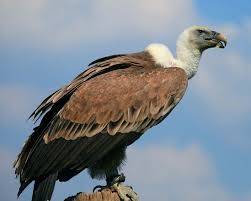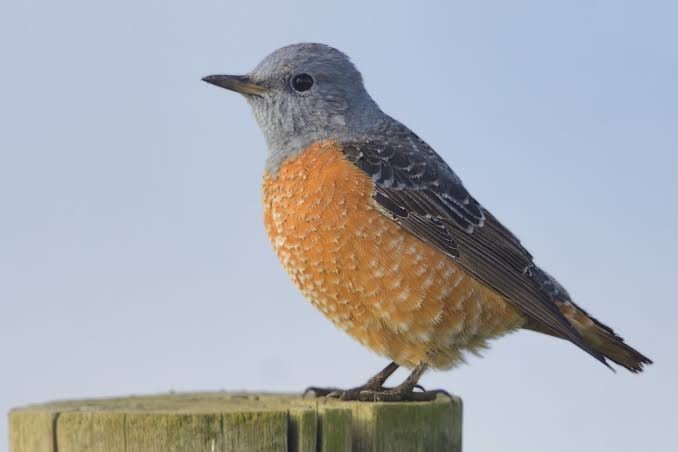Long-billed Vulture
The population of the long-billed vulture has seen a steady increase between 2015 and 2021, with the species exhibiting a 74% breeding success rate in the Mudumalai Tiger Reserve (MTR).
- It is a medium-sized bird of prey (any bird that pursues other animals for food) native to the Indian subcontinent.
- Scientific Name - Gyps Indicus.
- Family – Accipitridae.
- It is also known as the Indian vulture, Indian Griffon.
- Appearance - It features a light brown body with a dark head and neck, and it has a pale bill and collar that is more prominent behind the neck.
- It is similar to Slender-billed Vulture, but Indian Vultures are not as lanky and have a paler bill and very tiny ear holes.

- Distribution - Found in India and South East Pakistan.
- Natural habitat - Found in cities, towns and villages near cultivated area and open woody areas.
- Diet - Long-billed Vulture feeds exclusively on carrion, and mainly remains of cattle.
- Breeding season - November to March. Female lays one single whitish egg.
- Nesting - Nests in small colonies usually on cliffs. Nests are enormous and constructed with the help of sticks and lined with green leaves and rubbish. Both adults share the nesting duties.
- Conservation status
- IUCN - Critically endangered.
- CITES - Appendix II.
- WPA, 1972 – Schedule 1.
- Threats
- Forest fires
- The use of non-steroidal anti-inflammatory drugs, like diclofenac, in treating cattle, and
- Farmers indulging in retaliatory poisoning of tigers and leopards that occasionally prey on domestic cattle.
|
Mudumalai Tiger Reserve
|
- Mudumalai Tiger Reserve (MTR) is located in the Nilgiri District of Tamil Nadu.
- It is at the tri-junction of Karnataka, Kerala and Tamil Nadu.
- The Tiger Reserve comprises of the wildlife sanctuary and the national park of the same name.
- It forms a part of the Nilgiris Biosphere Reserve.
- It has a common boundary with Wayanad Wildlife Sanctuary (Kerala) on the West, Bandipur Tiger Reserve (Karnataka) on the North.
- The Moyar River flows downstream into the Mudumalai Tiger Reserve and is the natural line of division between Mudumalai and Bandipur Sanctuary.
- Other 2 vulture species observed in the reserve are the white rumped vulture and Asian king vulture.
|
Reference
The Hindu | Long-billed vulture’s nesting success rate
Diphtheria
A 3-year-old girl died of suspected diphtheria in Punjab’s Faridkot recently.
- Diphtheria is a highly contagious but preventable bacterial disease.
- A toxin produced by some strains of the Corynebacterium diphtheria bacteria results in diphtheria.
- Types - There are 2 types of diphtheria - respiratory and cutaneous.
- Respiratory diphtheria affects the nose, throat, and tonsils, while cutaneous diphtheria affects the skin.
- Transmission - It is spread through the air or by contact with an infected person.
- It affects the respiratory tract and spreads throughout the body.
- Symptoms - Fever, chills, swelling in lymph nodes, fatigue, shortness of breath, etc.
- Prevention - Immunisation is the best prevention against it, with the full schedule requiring seven doses between 0-16 years.
- Three doses are given before the child turns one, a booster Diphtheria, Pertussis and Tetanus (DPT) shot when the child is two, a fifth dose when the child turns six, and one each in years 10 and 16.

According to the Ministry of Health and Family Welfare, 93.5% of Indian children in the one-year age bracket were immunised in 2023-24 while Punjab’s numbers stood at 93.96%.
- Treatment
- Respiratory diphtheria - Treatment usually involves diphtheria antitoxin and antibiotics.
- Skin infections - Generally, only antibiotics are used.
- Prevalence - Data from 2023-24 states that almost 84% of diphtheria cases in India were reported from 10 states
- Kerala, Assam, Delhi, Gujarat, Haryana, Karnataka, Nagaland, Maharashtra, Rajasthan and West Bengal.
Reference
The Indian Express | Suspected diphtheria death in Punjab
Rufous-tailed rock thrush
The female Rufous-tailed rock thrush was recently spotted in Kanniyakumari Wildlife Sanctuary could be a passage migrant to Africa.
- It is a distinctive, small, short-tailed thrush-like bird.
- Scientific Name - Monticola saxatilis.
- Family - Muscicapidae.
- It is known as Common rock thrush.
- Appearance
- Males are strikingly beautiful with bright blue-gray head, white back patch, and chestnut underparts.
- Females are reddish-brown and have a scaly appearance, with a tail pattern similar to males.
- Distribution - Europe, northwestern Africa, and parts of Asia
- Breeding - Breeds on rocky mountain slopes and alpine meadows, usually above 1,500 m (5,000 ft).
- Migration - It migrates to Africa during the non-breeding season.
- Diet - It is omnivorous, eating a wide range of insects, berries and small reptiles.
- Behavior - Usually shy but may be obvious when delivering its melodic Eurasian Blackbird-like song in flight. The male common rock thrush has a clear and tuneful song.
- Conservation status
- Threats - Habitat loss and degradation and indiscriminate shooting.

|
Kanyakumari Wildlife Sanctuary
|
- The sanctuary is widely known to be a tiger reserve and is known to be a wildlife corridor
- Declared in - 2008.
- Rivers - 7 rivers have their origin in this forest including the famous Pahrali and Thamirabarani rivers.
- Vegetation - Southern thorn forests, dry deciduous, moist deciduous, semi evergreen forests and ever green hill sholas with grassy downs.
- Fauna - Indian Bison, Elephant, Nilgiri Tahr, Sambar Deer, Lion-tailed Macaque and also reptiles such as Indian Rock Python.
- Other spotted birds - Persian shearwater (Puffinus persicus) and Willow warbler (Phylloscopus trochilus).
|
Reference
The Hindu | Rufous-tailed rock thrush
Korean Peninsula
North Korea has adopted a renewed aggressive stance in the face of tensions with its neighbour, South Korea.
- The Korean Peninsula is a peninsula in East Asia that is made up of the Korean mainland and more than 3,960 nearby islands.
- It's located between China and Japan.
- It is bordered by the Yellow Sea to the west, the East China Sea and Korea Strait to the south, and the East Sea to the east.
- The Yalu and Tumen rivers form the border between North Korea and China.
- Japan is located just east of the Korean Peninsula across the Korean Strait.
- The highest peak in North Korea rises more than nine thousand feet.
- The Korean Peninsula is politically divided into North Korea and South Korea, with each country claiming sovereignty over the entire region
- North Korea, also known as the Democratic People's Republic of Korea (DPRK) with its capital Pyongyang.
- South Korea, also known as the Republic of Korea (ROK) with its capital Seoul.
- The two countries fought the Korean War from 1950 to 1953. These countries have been separated by the Korean demilitarized zone (DMZ) since 1953.
- Approximately 70 percent of the Korean Peninsula is mountainous.
- The Korean Peninsula is known for its dolmens, which are large rocks that were erected over thousands of years.
- Many dolmens can be found across the Korean Peninsula, and some have been designated as UNESCO World Heritage sites.

Reference
The Indian Express | Korean Peninsula
International Abhidhamma Divas
Ministry of Culture in collaboration with the International Buddhist Confederation (IBC) celebrated the International Abhidhamma Divas (October 17) recently in New Delhi.
- Abhidhamma Divas commemorates Lord Buddha’s descent from the celestial realm after delivering his teachings on the Abhidhamma, a core component of Buddhist philosophy.
- Lord Buddha descended from the celestial realm, Tavatiṃsa-devaloka, to Sankassiya (now Sankisa Basantapur) in Uttar Pradesh.
- The Asokan Elephant Pillar, a historical marker at the site, marks this significant event.
The Ashokan Elephant Pillar is a 3rd century BCE artifact in Sankissa, Uttar Pradesh built by Emperor Ashoka the Great. It has a unique capital with 4 elephants standing back-to-back, supporting a circular abacus.
- According to Theravada Buddhist texts, Lord Buddha spent 3 months teaching the Abhidhamma to the deities in Tavatiṃsa, including his mother.
- Abhidhamma Pinaka - Later he conveyed these teachings to his disciple Sariputta, who expanded upon them in the 6 core books of the Abhidhamma Pinaka.
- These texts cover various topics, such as moral and mental states, aggregates, causal relationships, and the path to emancipation, understanding the mind and achieving spiritual growth.
- The 7 treatises of the Abhidhamma Pinaka, notably the Pannhana, delve into causal relations with unparalleled depth, showcasing the Buddha's profound insight.
- The celebration of Abhidhamma Divas coincides with the end of the first Rainy Retreat (Vassa) and the Pavaraņa festival, a time when monks and nuns conclude their retreat period with a ceremony.
- The Abhidhamma, or "Higher Teaching" of the Buddha, provides a profound and systematic analysis of mind and matter.
- Unlike the more conventional teachings in the Sutta Piṭaka, which use everyday language, the Abhidhamma adopts a specialized and analytical approach to explore reality.
- It offers a detailed framework for understanding the nature of existence, addressing the processes of birth, death, and mental phenomena in a precise and abstract manner.
- Vocabulary - To convey these intricate concepts, the Abhidhamma developed a specialized vocabulary in Pali, forming the basis of Buddhist philosophy and psychology.
- Key terms - "citta" (consciousness), "cetasika" (mental factors), "rupa" (materiality), and "nibbana" (final liberation).
- The meticulous analysis provided by these texts has made the Abhidhamma an essential tool for practitioners seeking to develop insight and grasp the essence of Buddha's teachings.
|
Significance of Pali
|
- Pali was recently recognized as having a classical language status.
- The entire body of Buddhist canonical literature is written in Pali, with the Tipitaka or "Threefold Basket" being its most notable collection.
- This includes the
- Vinaya Pitaka, which outlines ethical monastic rules,
- Sutta Pitaka, a rich compilation of the Buddha's discourses, and
- Abhidhamma Pitaka, which delves into ethics, psychology, and the intricate analysis of mind and reality.
- A rich commentarial tradition has developed around these texts, with works such as the Aṭṭhasalini and Sammohavinodani being crucial for understanding the nuanced teachings of the Abhidhamma.
- Moreover, Pali literature encompasses the Jataka Kathas, which recount the stories of the Buddha's previous lives, reflecting shared moral values prevalent among the Indian populace.
|
Reference
PIB | International Abhidhamma Divas



